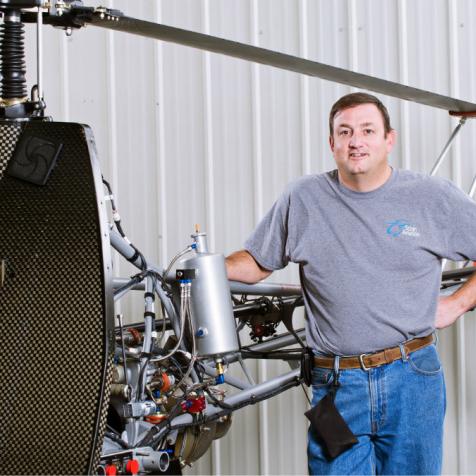
Scion Aviation / Scion UAS
By Eric Peterson | Dec 03, 2014
Company Details
Location
Fort Collins, Colorado
Founded
2011
Ownership Type
Private
Employees
14
Products
Helicopters
www.scionaviation.com / www.scionuas.com
Fort Collins, Colorado
Founded: 1994 / 2011
Privately owned
Employees: 14 (combined)
CEO Jim Sampson aims to reinvent the helicopter with cutting-edge composites and unmanned systems.
After graduating from Embry-Riddle Aeronautical University in Daytona Beach, Florida, in 1994, Sampson immediately founded Scion Aviation at the Fort Collins-Loveland Municipal Airport.
He saw a market that was in need of innovation. "In the '90s, most of the helicopters flying around were basically repurposed Vietnam-era machines," Sampson explains. "It was the first real helicopter war."
Texas-based Bell Helicopter had a lock on the market thanks to military contracts during the war. As Sampson puts it, "Bell got a big head start into the helicopter world. Once the war ended, Bell moved into the civilian market."

The company's near-monopoly made for little incentive to improve helicopter technology, leading to the opportunity Sampson sensed in 1994. ”[Bell] really left it alone," he says. "It was an old, tired design."
Nonetheless, the company dominated the helicopter market for decades. "They kind of got fat and happy," says Sampson.
With Scion, he aimed to bring composite materials and other advanced technologies to helicopter manufacturing, but the company was all but shut down by 9/11. Just as the company got rolling again, the financial crisis of 2008 presented more hurdles.
"Basically, what we were doing between 9/11 and 2011 -- and even today -- was for-hire work," says Sampson. Scion has become a go-to prototype manufacturer for Lockheed Martin, Boeing, and other titans of aerospace. Sampson attributes the contract success to Scion being "quick and easy instead of trying to beat it through their bureaucracy."
Through this work, another opportunity presented itself in 2011 in the form of unmanned aerial systems -- a.k.a drones. -- and Sampson launched Scion UAS with his colleagues. "We saw a real need for a more affordable option," he says.
Scion UAS does this by integrating existing technology into unmanned helicopters that range from 400 to 1,200 pounds, including the $350,000 SA-200 Weasel and the $1.2 million SA-400 Jackal.

Most of the competition is at least 10 times more expensive. "They're designed and puprosely built as a military asset," explains Sampson. "Ours is designed as a commmercial asset and we also sell to the military." The first deliveries went to the U.S. Naval Research Laboratory in October.
"Predominantly, the mission is reconnaissance and security," says Sampson. But that will change when the Federal Aviation Administration (FAA) opens up the airspace to commercial drones. Sampson anticipates the biggest markets will be precision agriculture, oil and gas exploration, and infrastructure inspection and management -- "things like pipelines and power lines."
Congress mandated the FAA to change its no-drone policy in the U.S. by 2015, but that target looks unlikely, Sampson notes. "The FAA is wavering," he says. "It won't be all at once. It's going to be special uses first."
After the FAA makes a more drone-friendly airspace, Scion UAS will be well-positioned for commercial market. Users will be able to throw it in a pickup truck, deploy it, and bring it home at a much lower price point than a manned mission.

Scion Aviation is actively manufacturing fuselages, frame components, and other composite parts. The company is also actively bidding on major contracts for complete aircraft that Sampson says could spur "explosive growth" as soon as 2015.
Composites and aerospace are a great match. "With anything that leaves the ground, weight is the driving factor," says Sampson.
Challenges: "The biggest challenge for the UAS company is the FAA and getting the legal hurdles out of the way so we can start delivering to customers who are literally begging for our products," says Sampson. "But there's only so much you can do."
Opportunities: "The opportunity right now is in foreign countries like Canada," says Sampson. "They're moving a lot faster. Canada's a place we can actually fly in today." He also points to the developing world as a big international market for security and energy exploration.
Needs: Aerospace talent. "Going into ramp-up as the rules and regulations allow, we're going to hire a lot of employees," says Sampson. "Getting people who are properly trained is difficult." He hopes to recruit from aerospace hubs like Seattle and Wichita, but notes that Scion UAS will predominately look to univiersities like CU Boulder and Georgia Tech.

